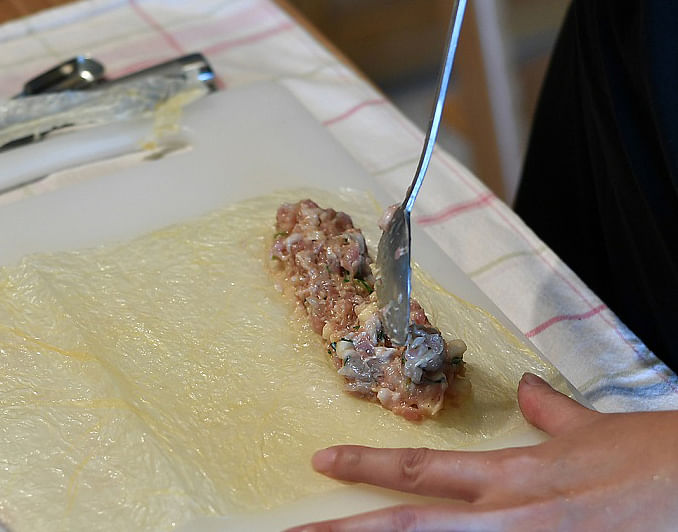Singapore Cooks
A foolproof recipe for ngoh hiang
Housewife Lois Watson makes good use of leftover food as filling for popiah or ngoh hiang

Growing up, food wastage was never allowed in the home of Mrs Lois Watson.
During Chinese New Year, any leftover food from the festive feasting would all be cooked together and used as filling for popiah in subsequent meals.
The 43-year-old housewife, who was born to hawker parents and is the youngest of seven siblings, recalls: "There was never any food wasted. Sometimes, if we had fried beehoon as a dish for CNY, you'd see it the next day in the popiah. It's a good way to eat leftovers."
Her parents used to sell fruit along Campbell Lane, before moving to Tekka Market to sell clothes.
The family's habit of not wasting food also applies to ngoh hiang, which is a common Chinese New Year dish for her family.
As she makes her family's version of the five-spice meat roll, she spoons the seasoned pork and prawn mixture onto the dried beancurd skin and is careful to push in the ends of the skin into the meat.
"We do so to not lose any of the filling. Once the meat is steamed, it is set, and will not 'explode' when it is fried," says Mrs Watson, whose 52-year-old programme manager husband is English. They have two sons, aged seven and four.
She also recommends using pork belly for a good balance of fat, meat and muscle.
So if you are buying meat from a butcher at the wet market, she says: "Tell the butcher you are going to make ngoh hiang, then he won't mince the meat too fine and will retain the fat."
She is careful not to mix all the ingredients with the seasoning in one go, so that she can adjust the flavours and season to taste. The raw meat mixture is best left to marinate overnight in the refrigerator for "maximum flavour".
Other ingredients, such as carrots and mushrooms, can be added to the mix and pork can be substituted with chicken.
For this "fool-proof and versatile" recipe, the meat mixture can be used as filling for wonton, or for yong tau foo. Simply scoop the mixture on top of beancurd and steam, says Mrs Watson, who is a part-time instructor at cooking school Food Playground in Chinatown.
She picked up the ngoh hiang recipe during her secondary school days, but from a young age, had observed her mother and older sisters making it.
"When there was food being deep-fried, I would be waiting in the kitchen for some crumbs. So they told me if I wanted to eat, I had to learn to cook."
She has fond memories of making bak chang (rice dumplings) with the family, simmering soup over a charcoal fire, and pounding cream crackers with a mortar and pestle as a coating for Hainanese pork chops.
Her passion for cooking Western food grew after living in Germany for five years, when her husband was posted there for work.
They returned to Singapore two years ago and Mrs Watson cooks about three times a week for her family. One-pot meals work best for her, as do pasta dishes or a simple stir-fry.
While her sons have yet to pick up her love of cooking, they are getting a head start by learning about ingredients.
But they are not doing so by browsing her collection of cookbooks by celebrity chefs such as Nigella Lawson, Gordon Ramsay, Jamie Oliver and Mary Berry.
Instead, their "pre-bedtime entertainment" is YouTube, watching food videos from popular food channel Tasty.
Mrs Watson says, chuckling: "Watching the videos hasn't pushed them into the kitchen yet. They tell me, 'Mummy can you cook this' or 'I like to eat this'. I take the opportunity to teach them about ingredients first. At least they learn something."
NGOH HIANG
INGREDIENTS
500g pork belly, coarsely minced
500g prawns, shelled, deveined and coarsely chopped
9 water chestnuts, peeled and diced into 2cm cubes
2 stalks spring onion, finely sliced
4 to 5 peeled shallots, finely sliced
3 to 4 peeled garlic cloves, finely chopped
For the seasoning:
2 Tbs soya sauce
1 Tbs oyster sauce
1 Tbs sesame oil
A dash of white pepper
1 tsp five-spice powder
3 tsp sugar
1/2 tsp salt
4 Tbs corn flour
1 egg
1 large sheet of dried beancurd skin
Water for steaming
200ml oil for frying
METHOD
1. In a large bowl, mix the pork and prawns together, add the water chestnuts, spring onion, shallots and garlic and continue to mix.
2. Next, mix the soya sauce, oyster sauce, sesame oil, white pepper, five-spice powder, sugar and salt in a small bowl. Add the seasoning, 1 Tbs at a time, to the meat mixture. This is to ensure that the mixture does not become too wet, which will make the skin soggy.
3. Mix 3 Tbs of the corn flour and the egg into the mixture.
4. To assemble, place the beancurd skin on a clean surface. Slice the skin into 15cm squares.
5. In a small bowl, mix the remaining 1 Tbs of corn flour with 2 Tbs of water.

6. Starting from the side nearest to you, pat 2 to 3 Tbs of the filling into a cylindrical mound (above). Make sure that the filling is evenly distributed.
7. From the end with the filling, roll the sheet over to form a tight cylinder and dab the corn flour liquid across the other end, so that the skin "sticks" to the surface. Use your finger to tuck the sides of the skin into the meat. Gently shape the ngoh hiang into an even-sized cylinder, for even cooking.
8. Continue steps 6 and 7 to make the remaining rolls.
9. Boil water in a pot or wok. Steam the ngoh hiang for about 15 to 20 minutes or until the beancurd skin turns to a pale yellow. Set aside. At this point, you can freeze the ngoh hiang for frying on another day.
10. Heat the oil in a deep pan or wok over medium heat. Fry the ngoh hiang for about five minutes on each side, until golden brown. If you choose not to steam the ngoh hiang first, then deep-fry it for about 10 minutes on each side.
11. Remove from the heat, slice and serve hot.
Makes 16 rolls
Join ST's Telegram channel and get the latest breaking news delivered to you.
A version of this article appeared in the print edition of The Sunday Times on July 09, 2017, with the headline A foolproof recipe for ngoh hiang. Subscribe

